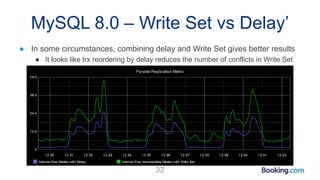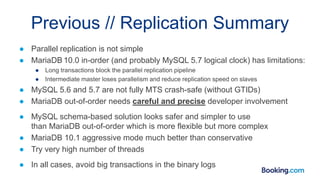MySQL Parallel Replication (LOGICAL_CLOCK): all the 5.7 (and some of the 8.0) details
- 1. MySQL Parallel Replication (LOGICAL_CLOCK): all the 5.7 (and some of the 8.0) details Jean-François Gagné (System Engineer) jeanfrancois DOT gagne AT booking.com April 27, 2017 – Percona Live Santa Clara 2017
- 2. 2
- 3. Booking.com ● Based in Amsterdam since 1996 ● Online Hotel and Accommodation (Travel) Agent (OTA): ● +1.220.000 properties in 227 countries ● +1.200.000 room nights reserved daily ● +40 languages (website and customer service) ● +13.000 people working in 187 offices worldwide ● Part of the Priceline Group ● And we use MySQL: ● Thousands (1000s) of servers, ~90% replicating ● >150 masters: ~30 >50 slaves & ~10 >100 slaves 3
- 4. Booking.com’ ● And we are hiring ! ● MySQL Engineer / DBA ● System Administrator ● System Engineer ● Site Reliability Engineer ● Developer / Designer ● Technical Team Lead ● Product Owner ● Data Scientist ● And many more… ● https://workingatbooking.com/ 4
- 5. Session Summary 1. Introducing Parallel Replication (// Replication) 2. Reminders of previous session 3. MySQL 5.7: Logical Clock and Intervals 4. MySQL 5.7: Tuning Intervals 5. MySQL 8.0 and Group Replication: Write Set 5
- 6. // Replication ● Relatively new because it is hard ● It is hard because of data consistency ● Running trx in // must give the same result on all slaves (= the master) ● Why is it important ? ● Computers have many Cores, using a single one for writes is a waste ● Some computer resources can give more throughput when used in parallel (RAID1 has 2 disks we can do 2 Read IOs in parallel) (SSDs can serve many Read and/or Write IOs in parallel) 6
- 7. Reminder ● MySQL 5.6 has support for schema based parallel replication ● MariaDB 10.0 has support for domain id based parallel replication and also has support for group commit based parallel replication ● MariaDB 10.1 adds support for optimistic parallel replication ● MySQL 5.7 adds support for logical clock parallel replication ● In early version, the logical clock is group commit based ● In current version, the logical clock is interval based ● MySQL 8.0 adds support for Write Set parallelism identification 7
- 8. MySQL 5.7: LOGICAL CLOCK ● MySQL 5.7 has two slave_parallel_type: ● both need “SET GLOBAL slave_parallel_workers = N;” (with N > 1) ● DATABASE: the schema based parallel replication from MySQL 5.6 ● LOGICAL_CLOCK: “Transactions that are part of the same binary log group commit on a master are applied in parallel on a slave.” (from the doc. but not exact: Bug#85977) ● the LOGICAL_CLOCK type is implemented by putting interval information in the binary logs ● Slowing down the master to speedup the slave: ● binlog_group_commit_sync_delay ● binlog_group_commit_sync_no_delay_count ● We can expect the same problems as with MariaDB 10: ● Problems with long/big transactions ● Problems with intermediate masters (IM) 8
- 9. MySQL 5.7: LOGICAL CLOCK ● By default, MySQL 5.7 in logical clock does out-of-order commit: There will be gaps (“START SLAVE UNTIL SQL_AFTER_MTS_GAPS;”) ● Not replication crash safe without GTIDs http://jfg-mysql.blogspot.com/2016/01/replication-crash-safety-with-mts.html ● And also everything else: binary logs content, SHOW SLAVE STATUS, skipping transactions, backups, … ● Using slave_preserve_commit_order = 1 does what you expect: ● This configuration does not generate gap ● But it needs log-slave-updates, there is a feature request to remove this limitation: Bug#75396 ● And it is still not replication crash safe (surprising because no gap): Bug#80103 & Bug#81840 9
- 10. MySQL 5.7 – Intervals ● To understand MySQL 5.7, let’s look at something simpler first ● In MariaDB 10, each trx in the binlogs is tagged with a Group Commit Id (cid) ... #150316 11:33:46 ... GTID 0-1-184 cid=2324 #150316 11:33:46 ... GTID 0-1-185 cid=2335 ... #150316 11:33:46 ... GTID 0-1-189 cid=2335 #150316 11:33:46 ... GTID 0-1-190 #150316 11:33:46 ... GTID 0-1-191 cid=2346 ... #150316 11:33:46 ... GTID 0-1-197 cid=2346 #150316 11:33:46 ... GTID 0-1-198 cid=2361 ... 10
- 11. MySQL 5.7 – Intervals’ ● In MySQL 5.7, each transaction is tagged with two (2) numbers: ● sequence_number: increasing id for each trx (not to confuse with GTID) ● last_committed: sequence_number of the latest trx on which this trx depends (This can be understood as the “write view” of the current transaction) ● The last_committed / sequence_number pair is the parallelism interval ● Here an example of intervals for MySQL 5.7: ... #170206 20:08:33 ... last_committed=6201 sequence_number=6203 #170206 20:08:33 ... last_committed=6203 sequence_number=6204 #170206 20:08:33 ... last_committed=6203 sequence_number=6205 #170206 20:08:33 ... last_committed=6203 sequence_number=6206 #170206 20:08:33 ... last_committed=6205 sequence_number=6207 ... 11
- 12. MySQL 5.7 – Intervals Generation ● sequence_number is an increasing id for each trx (not GTID) (Reset to 1 at the beginning of each new binary log) ● last_committed is (in MySQL 5.7) the sequence number of the most recently committed transaction when the current transaction gets its last lock (Reset to 0 at the beginning of each new binary log) ... #170206 20:08:33 ... last_committed=6201 sequence_number=6203 #170206 20:08:33 ... last_committed=6203 sequence_number=6204 #170206 20:08:33 ... last_committed=6203 sequence_number=6205 #170206 20:08:33 ... last_committed=6203 sequence_number=6206 #170206 20:08:33 ... last_committed=6205 sequence_number=6207 ... 12
- 13. MySQL 5.7 – Intervals Quality ● For MariaDB 10, the parallelism identification quality is the “Group Commit Size” 13
- 14. Importance of tuning in MariaDB 10
- 15. MySQL 5.7 – Intervals Quality ● For MariaDB 10, the // identification quality metric is the “Group Commit Size” ● For MySQL 5.7, it is not as straightforward ● For measuring parallelism identification quality with MySQL 5.7, I came up with a metric: the Average Modified Interval Length (AMIL) ● If we prefer to think in terms of group commit size, the AMIL can be mapped to a pseudo-group commit size by multiplying the AMIL by 2 and subtracting one ● For a group commit of size n, the sum of the intervals length is n*(n+1) / 2 #170206 20:08:33 ... last_committed=6203 sequence_number=6204 #170206 20:08:33 ... last_committed=6203 sequence_number=6205 #170206 20:08:33 ... last_committed=6203 sequence_number=6206 15
- 16. MySQL 5.7 – Intervals Quality ● For MariaDB 10, the // identification quality metric is the “Group Commit Size” ● For MySQL 5.7, it is not as straightforward ● For measuring parallelism identification quality with MySQL 5.7, I came up with a metric: the Average Modified Interval Length (AMIL) ● If we prefer to think in terms of group commit size, the AMIL can be mapped to a pseudo-group commit size by multiplying the AMIL by 2 and subtracting one ● For a group commit of size n, the sum of the intervals length is n*(n+1)/2 AMIL = (n+1)/2 (after dividing by n), algebra gives us n = AMIL * 2 - 1 ● This mapping gives a hint on the value needed for slave_parallel_workers (http://jfg-mysql.blogspot.com/2017/02/metric-for-tuning-parallel-replication-mysql-5-7.html) 16
- 17. MySQL 5.7 – Intervals Quality’ ● Why do we need to “modify” the interval length ? ● Because of a limitation in the current MTS applier which will only start trx 93136 once 93131 is completed last_committed=93124 is modified to 93131 #170206 21:19:31 ... last_committed=93124 sequence_number=93131 #170206 21:19:31 ... last_committed=93131 sequence_number=93132 #170206 21:19:31 ... last_committed=93131 sequence_number=93133 #170206 21:19:31 ... last_committed=93131 sequence_number=93134 #170206 21:19:31 ... last_committed=93131 sequence_number=93135 #170206 21:19:31 ... last_committed=93124 sequence_number=93136 #170206 21:19:31 ... last_committed=93131 sequence_number=93137 #170206 21:19:31 ... last_committed=93131 sequence_number=93138 #170206 21:19:31 ... last_committed=93132 sequence_number=93139 #170206 21:19:31 ... last_committed=93138 sequence_number=93140 17
- 18. MySQL 5.7 – Intervals Quality’’ ● Script to compute the Average Modified Interval Length: file=my_binlog_index_file; echo _first_binlog_to_analyse_ > $file; mysqlbinlog --stop-never -R --host 127.0.0.1 $(cat $file) | grep "^#" | grep -e last_committed -e "Rotate to" | awk -v file=$file -F "[ t]*|=" '$11 == "last_committed" { if (length($2) == 7) {$2 = "0" $2;} if ($12 < max) {$12 = max;} else {max = $12;} print $1, $2, $14 - $12;} $10 == "Rotate"{print $12 > file; close(file); max=0;}' | awk -F " |:" '{my_h = $2 ":" $3 ":" $4;} NR == 1 {d=$1; h=my_h; n=0; sum=0; sum2=0;} d != $1 || h < my_h {print d, h, n, sum, sum2; d=$1; h=my_h;} {n++; sum += $5; sum2 += $5 * $5;}' (http://jfg-mysql.blogspot.com/2017/02/metric-for-tuning-parallel-replication-mysql-5-7.html) 18
- 19. MySQL 5.7 – Intervals Quality’’’ ● AMIL without and with tuning (delay) on four (4) Booking.com masters: 19
- 20. MySQL 5.7 – Intervals Quality’’’ ’ ● Computing the AMIL needs parsing the binary logs ● This is complicated and needs to handle many special cases ● Exposing counters for computing the AMIL would be better: ● Bug# 85965: Expose, on the master, counters for monitoring // information quality. ● Bug# 85966: Expose, on slaves, counters for monitoring // information quality. (http://jfg-mysql.blogspot.com/2017/02/metric-for-tuning-parallel-replication-mysql-5-7.html) 20
- 21. MySQL 8.0 – Write Set ● MySQL 8.0.1 has a new way to identify parallelism ● Instead of setting last_committed to “the seq. number of the most recently committed transaction when the current trx gets its last lock”… ● MySQL 8.0.1 uses “the sequence number of the last transaction that updated the same rows as the current transaction” ● To do that, MySQL 8.0 remembers which rows (tuples) are modified by each transaction: this is the Write Set ● Write Set are not put in the binary logs, they allow to “widen” the intervals 21
- 22. MySQL 8.0 – Write Set’ ● MySQL 8.0.1 introduces new global variables to control Write Set: ● transaction_write_set_extraction = [ OFF | XXHASH64 ] ● binlog_transaction_dependency_history_size (default to 25000) ● binlog_transaction_dependency_tracking = [ COMMIT_ORDER | WRITESET_SESSION | WRITESET ] ● WRITESET_SESSION: no two updates from the same session can be reordered ● WRITESET: any transactions which write different tuples can be parallelized ● WRITESET_SESSION will not work well for cnx recycling (Cnx Pools or Proxies): ● Recycling a connection with WRITESET_SESSION impedes parallelism identification 22
- 23. MySQL 8.0 – Write Set’’ ● To use Write Set on a Master: ● transaction_write_set_extraction = XXHASH64 ● binlog_transaction_dependency_tracking = [ WRITESET_SESSION | WRITESET ] ● To use Write Set on an Intermediate Master (even single-threaded): ● transaction_write_set_extraction = XXHASH64 ● binlog_transaction_dependency_tracking = WRITESET ● To stop using Write Set: ● binlog_transaction_dependency_tracking = COMMIT_ORDER ● transaction_write_set_extraction = OFF 23
- 24. MySQL 8.0 – Write Set’’’ ● Result for single-threaded Booking.com Intermediate Master (before and after): #170409 3:37:13 [...] last_committed=6695 sequence_number=6696 [...] #170409 3:37:14 [...] last_committed=6696 sequence_number=6697 [...] #170409 3:37:14 [...] last_committed=6697 sequence_number=6698 [...] #170409 3:37:14 [...] last_committed=6698 sequence_number=6699 [...] #170409 3:37:14 [...] last_committed=6699 sequence_number=6700 [...] #170409 3:37:14 [...] last_committed=6700 sequence_number=6701 [...] #170409 3:37:14 [...] last_committed=6700 sequence_number=6702 [...] #170409 3:37:14 [...] last_committed=6700 sequence_number=6703 [...] #170409 3:37:14 [...] last_committed=6700 sequence_number=6704 [...] #170409 3:37:14 [...] last_committed=6704 sequence_number=6705 [...] #170409 3:37:14 [...] last_committed=6700 sequence_number=6706 [...] 24
- 25. MySQL 8.0 – Write Set’’’ ’ #170409 3:37:17 [...] last_committed=6700 sequence_number=6766 [...] #170409 3:37:17 [...] last_committed=6752 sequence_number=6767 [...] #170409 3:37:17 [...] last_committed=6753 sequence_number=6768 [...] #170409 3:37:17 [...] last_committed=6700 sequence_number=6769 [...] [...] #170409 3:37:18 [...] last_committed=6700 sequence_number=6783 [...] #170409 3:37:18 [...] last_committed=6768 sequence_number=6784 [...] #170409 3:37:18 [...] last_committed=6784 sequence_number=6785 [...] #170409 3:37:18 [...] last_committed=6785 sequence_number=6786 [...] #170409 3:37:18 [...] last_committed=6785 sequence_number=6787 [...] [...] #170409 3:37:22 [...] last_committed=6785 sequence_number=6860 [...] #170409 3:37:22 [...] last_committed=6842 sequence_number=6861 [...] #170409 3:37:22 [...] last_committed=6843 sequence_number=6862 [...] #170409 3:37:22 [...] last_committed=6785 sequence_number=6863
- 26. MySQL 8.0 – Write Set’’’ ’’ 26 ● AMIL on a single-threaded 8.0.1 Intermediate Master (IM) without/with Write Set:
- 27. MySQL 8.0 – Write Set’’’ ’’’ ● Write Set advantages: ● No need to slowdown the master ● Will work even at low concurrency on the master ● Allows to test without upgrading (works on an intermediate master) (however, this sacrifices session consistency, which might give optimistic results) ● Mitigate the problem of losing parallelism via intermediate masters (only with binlog_transaction_dependency_tracking = WRITESET) ( the best solution is still Binlog Servers) 27
- 28. MySQL 8.0 – Write Set’’’ ’’’ ’ ● Write Set limitations: ● Needs Row-Based-Replication on the master (or intermediate master) ● Not working for trx updating tables without PK and trx updating tables having FK (it will fall back to COMMIT_ORDER for those transactions) ● Barrier at each DDL (Bug#86060 for adding counters) ● Barrier at each binary log rotation: no transactions in different binlogs can be run in // ● With WRITESET_SESSION, does not play well with connection recycling (Could use COM_RESET_CONNECTION if Bug#86063 is fixed) ● Write Set drawbacks: ● Slowdown the master ? Consume more RAM ? ● New technology: not fully mastered yet and there are bugs (still 1st DMR release) 28
- 29. MySQL 8.0 – Write Set & Bugs ● I know of at least one case where Write Set miss a transaction dependency: ● Bad Write Set with UNIQUE KEY on a DELETE followed by an INSERT: Bug#86078 ● This happened 7 times for 5 million trx in 1 of 7 test environments (6 other are OK) ● Restarting the slave (START SLAVE;) resumed replication in my case ● This bug deadlock the SQL_THREAD with slave_preserve_commit_order = 1 ● Deadlock with slave_preserve_commit_order=ON with Bug#86078: Bug#86079 ● The only solution I found is to “kill -9” mysqld ● Both bugs above are not a surprise to me: ● Parallel replication is hard and MySQL 8.0 is young ● Many fixed bugs in MariaDB parallel repl. including MDEV-7326, 7458 and 10863 29
- 30. InnoDB Bugs ● Parallel Replication allows to identify old bugs ● An InnoDB race condition caused a query by Primary Key to do a full table scan: ● Hard to notice for a “1-in-a-million” SELECT (or UPDATE/DELETE on master) ● But obvious in replication: one of several slaves blocked for minutes on an UPDATE via PK (other slaves not blocked because did not hit the race condition) ● Bug#82968 (fixed in 5.7.18) and Bug#82969 (still open) https://www.facebook.com/valerii.kravchuk/posts/1073608056064467 ● What other interesting bugs will we find because of // replication ? 30
- 31. MySQL 8.0 – Write Set vs Delay ● AMIL on Booking.com masters with delay vs Write Set on Intermediate Master: 31
- 32. MySQL 8.0 – Write Set vs Delay’ ● In some circumstances, combining delay and Write Set gives better results ● It looks like trx reordering by delay reduces the number of conflicts in Write Set 32
- 33. MySQL 8.0 – Write Set Speedups 33 ● Tests on seven (7) real Booking.com environments (different workloads): ● A is MySQL 5.6 and 5.7 masters (3 and 4 respectively) ● B is MySQL 8.0.1 Intermediate Master with Write Set to identify parallelism (intervals) ● C1 and C2 are two slaves: one with SSDs and one with magnetic disks +---+ +---+ +---+ | A | -------> | B | ---+---> | C1| +---+ +---+ | +---+ | | +---+ +---> | C2| +---+
- 34. MySQL 8.0 – Write Set Speedups’ 34 ● I only have preliminary results: ● Alternating 2 minutes of single-threaded with 2 min. of MTS and stopping 30 sec. ● Only for slaves with binary logs enabled, log-slave-updates and high durability (sync_binlog=1 and trx_commit=1) ● Only one value of MTS: a “good” slave_parallel_workers is guessed ● Un-tuned application (probably un-optimal workload) ● Un-tuned mysqld (maybe unknown bottleneck) ● Measuring only once (but with many iterations)
- 35. MySQL 8.0 – Write Set Speedups’’ 35 SSDs 1.6 (50 / 0) Disks 1.1 (50 / 0) Nb Workers 4 ● For each of the seven (7) environments, I am reporting the following: ● Number of occurrences of bug (which voids the result of one iteration) ● Number of iterations (alternate 2m/2m/30s) ● Speedups for SSDs and magnetic disks ● Graphs for AMIL on IM and SSDs commit rate for 3 “selected” iterations
- 36. MySQL 8.0 – Write Set Speedups’’’ 36 SSDs 5.8 (20 / 0) Disks 3.8 (20 / 0) Nb Workers 16 SSDs 2.9 (15 / 0) Disks 2.5 (15 / 0) Nb Workers 8
- 37. MySQL 8.0 – Write Set Speedups’’’ ’ 37 SSDs 4.1 (15 / 0) Disks 2.5 (50 / 0) Nb Workers 32 SSDs 3.9 (10 / 3) Disks 2.4 (15 / 3) Nb Workers 16
- 38. MySQL 8.0 – Write Set Speedups’’’ ’’ 38 SSDs 6.9 (15 / 0) Disks 3.5 (50 / 0) Nb Workers 32 SSDs 1.8 (15 / 0) Disks 1.4 (50 / 0) Nb Workers 4
- 39. MySQL 8.0 – Write Set Speedups’’’ ’’’ 39 ● Summary for SSDs: ● Two (2) “interesting” speedups: 1.6, 1.8 ● Three (3) very good speedups: 2.9, 3.9, 4.1 ● Two (2) great speedups: 5.8, 6.9 ● Summary for Disks: ● Two (2) “small” speedups: 1.1, 1.4 ● Three (3) good speedups: 2.4, 2.5, 2.5 ● Two (2) very good speedups: 3.5, 3.8 ● All that without tuning MySQL or the application ● But we need to do more rigorous benchmarks
- 40. Write Set in Group Replication (5.7) ● Write Set is used in MySQL 5.7 for Group Replication (GR): ● Write Set is part of the certification process (conflict detection) ● Once accepting commit, Write Set is used to do parallel remote query execution ● Parallel remote query execution with Write Set explains why a MySQL 5.7 GR node can apply trx “faster” than an asynchronous slave ● With MySQL 8.0.1, an asynchronous slave should be as fast as GR 40
- 41. Previous // Replication Summary ● Parallel replication is not simple ● MariaDB 10.0 in-order (and probably MySQL 5.7 logical clock) has limitations: ● Long transactions block the parallel replication pipeline ● Intermediate master loses parallelism and reduce replication speed on slaves ● MySQL 5.6 and 5.7 are not fully MTS crash-safe (without GTIDs) ● MariaDB out-of-order needs careful and precise developer involvement ● MySQL schema-based solution looks safer and simpler to use than MariaDB out-of-order which is more flexible but more complex ● MariaDB 10.1 aggressive mode much better than conservative ● Try very high number of threads ● In all cases, avoid big transactions in the binary logs
- 42. MySQL 5.7 and 8.0 // Repl. Summary ● Parallel replication is still not simple (maybe even more complicated in 5.7 and 8.0: intervals, tuning, AMIL, … ● Write Set in MySQL 8.0.1 very promising: ● Some great speedups and most of them good ● But more rigorous test needs to be done ● Some feature requests and bugs (I am looking forward to the next version) ● Evolving understanding of the technology: expect new things ● Future work: ● A better replication applier for slaves (no barrier on 1st dependency) ● Slave Group Commit (is it useful ?) ● Optimistic parallel replication (is it better than Write Set ?)
- 43. And please test by yourself and share results
- 44. // Replication: Links ● Replication crash safety with MTS in MySQL 5.6 and 5.7: reality or illusion? https://jfg-mysql.blogspot.com/2016/01/replication-crash-safety-with-mts.html ● A Metric for Tuning Parallel Replication in MySQL 5.7 https://jfg-mysql.blogspot.com/2017/02/metric-for-tuning-parallel-replication-mysql-5-7.html ● Solving MySQL Replication Lag with LOGICAL_CLOCK and Calibrated Delay https://www.vividcortex.com/blog/solving-mysql-replication-lag-with-logical_clock-and-calibrated-delay ● How to Fix a Lagging MySQL Replication https://thoughts.t37.net/fixing-a-very-lagging-mysql-replication-db6eb5a6e15d ● Binlog Servers: ● http://blog.booking.com/mysql_slave_scaling_and_more.html ● Better Parallel Replication for MySQL: http://blog.booking.com/better_parallel_replication_for_mysql.html ● http://blog.booking.com/abstracting_binlog_servers_and_mysql_master_promotion_wo_reconfiguring_slaves.html 44
- 45. // Replication: Links’ ● Bugs/feature requests: ● The doc. of slave-parallel-type=LOGICAL_CLOCK wrongly reference Group Commit: Bug#85977 ● Allow slave_preserve_commit_order without log-slave-updates: Bug#75396 ● MTS with slave_preserve_commit_order not repl. crash safe: Bug#80103 ● Automatic Repl. Recovery Does Not Handle Lost Relay Log Events: Bug#81840 ● Expose, on the master/slave, counters for monitoring // info. quality: Bug#85965 & Bug#85966 ● Expose counters for monitoring Write Set barriers: Bug#86060 ● The function reset_connection does not reset Write Set in WRITESET_SESSION: Bug#86063 ● Bad Write Set tracking with UNIQUE KEY on a DELETE followed by an INSERT: Bug#86078 ● Deadlock with slave_preserve_commit_order=ON with Bug#86078: Bug#86079 ● Fixed bugs: ● Message after MTS crash misleading: Bug#80102 (and Bug#77496) ● Replication position lost after crash on MTS configured slave: Bug#77496 ● Full table scan bug in InnoDB: MDEV-10649, Bug#82968 and Bug#82969
- 46. Thanks Jean-François Gagné jeanfrancois DOT gagne AT booking.com





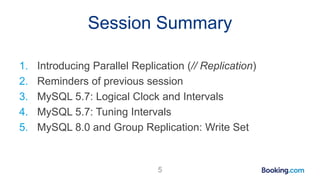




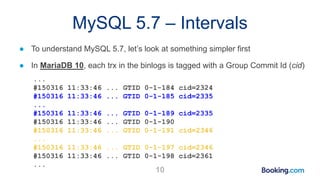


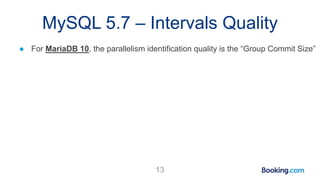

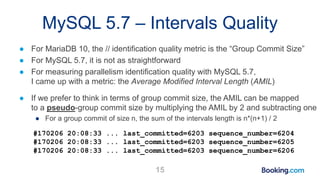


![MySQL 5.7 – Intervals Quality’’
● Script to compute the Average Modified Interval Length:
file=my_binlog_index_file;
echo _first_binlog_to_analyse_ > $file;
mysqlbinlog --stop-never -R --host 127.0.0.1 $(cat $file) |
grep "^#" | grep -e last_committed -e "Rotate to" |
awk -v file=$file -F "[ t]*|=" '$11 == "last_committed" {
if (length($2) == 7) {$2 = "0" $2;}
if ($12 < max) {$12 = max;} else {max = $12;}
print $1, $2, $14 - $12;}
$10 == "Rotate"{print $12 > file; close(file); max=0;}' |
awk -F " |:" '{my_h = $2 ":" $3 ":" $4;}
NR == 1 {d=$1; h=my_h; n=0; sum=0; sum2=0;}
d != $1 || h < my_h {print d, h, n, sum, sum2; d=$1; h=my_h;}
{n++; sum += $5; sum2 += $5 * $5;}'
(http://jfg-mysql.blogspot.com/2017/02/metric-for-tuning-parallel-replication-mysql-5-7.html)
18](https://image.slidesharecdn.com/2017-04-27plscmysqlparallelreplication-logicalclockdetails-170427223049/85/MySQL-Parallel-Replication-LOGICAL_CLOCK-all-the-5-7-and-some-of-the-8-0-details-18-320.jpg)



![MySQL 8.0 – Write Set’
● MySQL 8.0.1 introduces new global variables to control Write Set:
● transaction_write_set_extraction = [ OFF | XXHASH64 ]
● binlog_transaction_dependency_history_size (default to 25000)
● binlog_transaction_dependency_tracking = [ COMMIT_ORDER | WRITESET_SESSION | WRITESET ]
● WRITESET_SESSION: no two updates from the same session can be reordered
● WRITESET: any transactions which write different tuples can be parallelized
● WRITESET_SESSION will not work well for cnx recycling (Cnx Pools or Proxies):
● Recycling a connection with WRITESET_SESSION impedes parallelism identification
22](https://image.slidesharecdn.com/2017-04-27plscmysqlparallelreplication-logicalclockdetails-170427223049/85/MySQL-Parallel-Replication-LOGICAL_CLOCK-all-the-5-7-and-some-of-the-8-0-details-22-320.jpg)
![MySQL 8.0 – Write Set’’
● To use Write Set on a Master:
● transaction_write_set_extraction = XXHASH64
● binlog_transaction_dependency_tracking = [ WRITESET_SESSION | WRITESET ]
● To use Write Set on an Intermediate Master (even single-threaded):
● transaction_write_set_extraction = XXHASH64
● binlog_transaction_dependency_tracking = WRITESET
● To stop using Write Set:
● binlog_transaction_dependency_tracking = COMMIT_ORDER
● transaction_write_set_extraction = OFF
23](https://image.slidesharecdn.com/2017-04-27plscmysqlparallelreplication-logicalclockdetails-170427223049/85/MySQL-Parallel-Replication-LOGICAL_CLOCK-all-the-5-7-and-some-of-the-8-0-details-23-320.jpg)
![MySQL 8.0 – Write Set’’’
● Result for single-threaded Booking.com Intermediate Master (before and after):
#170409 3:37:13 [...] last_committed=6695 sequence_number=6696 [...]
#170409 3:37:14 [...] last_committed=6696 sequence_number=6697 [...]
#170409 3:37:14 [...] last_committed=6697 sequence_number=6698 [...]
#170409 3:37:14 [...] last_committed=6698 sequence_number=6699 [...]
#170409 3:37:14 [...] last_committed=6699 sequence_number=6700 [...]
#170409 3:37:14 [...] last_committed=6700 sequence_number=6701 [...]
#170409 3:37:14 [...] last_committed=6700 sequence_number=6702 [...]
#170409 3:37:14 [...] last_committed=6700 sequence_number=6703 [...]
#170409 3:37:14 [...] last_committed=6700 sequence_number=6704 [...]
#170409 3:37:14 [...] last_committed=6704 sequence_number=6705 [...]
#170409 3:37:14 [...] last_committed=6700 sequence_number=6706 [...]
24](https://image.slidesharecdn.com/2017-04-27plscmysqlparallelreplication-logicalclockdetails-170427223049/85/MySQL-Parallel-Replication-LOGICAL_CLOCK-all-the-5-7-and-some-of-the-8-0-details-24-320.jpg)
![MySQL 8.0 – Write Set’’’ ’
#170409 3:37:17 [...] last_committed=6700 sequence_number=6766 [...]
#170409 3:37:17 [...] last_committed=6752 sequence_number=6767 [...]
#170409 3:37:17 [...] last_committed=6753 sequence_number=6768 [...]
#170409 3:37:17 [...] last_committed=6700 sequence_number=6769 [...]
[...]
#170409 3:37:18 [...] last_committed=6700 sequence_number=6783 [...]
#170409 3:37:18 [...] last_committed=6768 sequence_number=6784 [...]
#170409 3:37:18 [...] last_committed=6784 sequence_number=6785 [...]
#170409 3:37:18 [...] last_committed=6785 sequence_number=6786 [...]
#170409 3:37:18 [...] last_committed=6785 sequence_number=6787 [...]
[...]
#170409 3:37:22 [...] last_committed=6785 sequence_number=6860 [...]
#170409 3:37:22 [...] last_committed=6842 sequence_number=6861 [...]
#170409 3:37:22 [...] last_committed=6843 sequence_number=6862 [...]
#170409 3:37:22 [...] last_committed=6785 sequence_number=6863](https://image.slidesharecdn.com/2017-04-27plscmysqlparallelreplication-logicalclockdetails-170427223049/85/MySQL-Parallel-Replication-LOGICAL_CLOCK-all-the-5-7-and-some-of-the-8-0-details-25-320.jpg)






